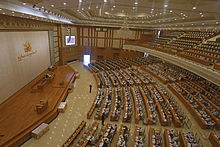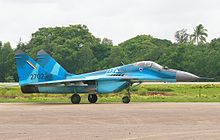Main article: Politics of Burma

Assembly of the Union (Pyidaungsu Hluttaw).
The legislature, called the Pyidaungsu Hluttaw, is bicameral and made up of two houses: The 224-seat upper house Amyotha Hluttaw (House of Nationalities) and the 440-seat lower house Pyithu Hluttaw (House of Representatives). The upper house consists of 224 members, of whom 168 are directly elected and 56 are appointed by the Burmese Armed Forces while the lower house consists of 440 members, of whom 330 are directly elected and 110 are appointed by the armed forces. The major political parties are the National League for Democracy, National Democratic Force and the two backed by the military: the National Unity Party, and the Union Solidarity and Development Party.
Burma's army-drafted constitution was approved in a referendum in May 2008. The results, 92.4% of the 22 million voters with an official turnout of 99%, are considered suspect by many international observers and by the National league of democracy with reports of widespread fraud, ballot stuffing, and voter intimidation.[104]
The elections of 2010 resulted in a victory for the military-backed Union Solidarity and Development Party and various foreign observers questioned the fairness of the elections.[105][106][107] One criticism of the election was that only government sanctioned political parties were allowed to contest in it and the popular National League for Democracy was declared illegal and is still barred from political activities.[108] However, immediately following the elections, the government ended the house arrest of the democracy advocate and leader of the National League for Democracy, Aung San Suu Kyi.[109] and her ability to move freely around the country is considered an important test of the military's movement toward more openness.[108] After unexpected reforms in 2011, NLD senior leaders have decided to register as a political party and to field candidates in future by-elections.[110]
Burma rates as a highly corrupt nation on the Corruption Perceptions Index with a rank of 180th out of 183 countries worldwide and a rating of 1.5 out of 10 (10 being least corrupt and 0 being highly corrupt) as of 2011.[111]
Foreign relations
Main article: Foreign relations of Burma
Though the country's foreign relations, particularly with Western
nations, have been strained, relations have thawed since the reforms
following the 2010 elections. After years of diplomatic isolation and
economic and military sanctions,[112] the United States relaxed curbs on foreign aid to Burma in November 2011[79] and announced the resumption of diplomatic relations on 13 January 2012[113] The European Union has placed sanctions on Burma, including an arms embargo, cessation of trade preferences, and suspension of all aid with the exception of humanitarian aid.[114]
U.S. and European government sanctions against the former military
government, coupled with boycotts and other direct pressure on
corporations by supporters of the democracy movement, have resulted in
the withdrawal from the country of most U.S. and many European
companies.[115] On 13 April 2012 British Prime Minister David Cameron
called for the economic sanctions on Burma to be suspended in the wake
of the pro-democracy party gaining 43 seats out of a possible 45 in the
2012 by-elections with the party leader, Aung San Suu Kyi becoming a member of the Burmese parliament.[116]Despite Western isolation, Asian corporations have generally remained willing to continue investing in the country and to initiate new investments, particularly in natural resource extraction. The country has close relations with neighbouring India and China with several Indian and Chinese companies operating in the country. Under India's Look East policy, fields of cooperation between India and Burma include remote sensing,[117] oil and gas exploration,[118] information technology,[119] hydro power[120] and construction of ports and buildings.[121] In 2008, India suspended military aid to Burma over the issue of human rights abuses by the ruling junta, although it has preserved extensive commercial ties, which provide the regime with much-needed revenue.[122] The thaw in relations began on 28 November 2011, when Belarusian Prime Minister Mikhail Myasnikovich and his wife Ludmila arrived in the capital, Naypyidaw, the same day as the country received a visit by US Secretary of State Hillary Clinton, who also met with pro-democracy opposition leader Aung San Suu Kyi.[123] International relations progress indicators continued in September 2012 when Aung San Suu Kyi visited to the US[124] followed by Burma's reformist president visit to the United Nations.[125]
In May 2013, Thein Sein became the first Myanmar president to visit the U.S. White House in 47 years and President Barack Obama praised the former general for political and economic reforms, and the cessation of tensions between Myanmar and the U.S. Political activists objected to the visit due to concerns over human rights abuses in Myanmar but Obama assured Thein Sein that Myanmar will receive the support from the U.S. Prior to President Thein Sein, the last Myanmar leader to visit the White House was Ne Win in September 1966. The two leaders discussed to release more political prisoners, the institutionalization of political reform and rule of law, and ending ethnic conflict in Myanmar—the two governments agreed to sign a bilateral trade and investment framework agreement on May 21, 2013.[126]
In June 2013, Myanmar held its first ever summit, the World Economic Forum on East Asia 2013. A regional spinoff of the annual World Economic Forum in Davos, Switzerland, the summit was held on June 5–7 and attended by 1,200 participants, including 10 heads of state, 12 ministers and 40 senior directors from around the world.[127]
Visits by Western leaders
In mid October, 2012. former UK Prime Minister Tony Blair "led a delegation" to shake hands with President Thein Sein, and met with lower house speaker Shwe Mann. A British embassy spokesperson said he was there on behalf of The Office of Tony Blair, an umbrella group of foundations—inter-faith, sports, etc.—and governance initiatives that he started up after leaving office. The spokesperson said only that he had "productive discussions about the reform process".[128]On 3 November 2012 European Commission President José Manuel Barroso met with Myanmar's President Thein Sein in Myanmar.[129][130]
On 6 November 2012 Australia's Prime Minister, Julia Gillard met with Myanmar's President Thein Sein on the sidelines of the 9th Asia–Europe Meeting becoming the first Australian head of government to meet Burma's leader in nearly 30 years.[131]
On 12 November 2012 Sweden's Prime Minister, Fredrik Reinfeldt, met President U Thein Sein at the presidential palace in the new capital, Naypyidaw, while being accompanied on his visit by the Swedish Trade Minister Ewa Björling and two business delegations.[132]
On 19 November 2012, US President Barack Obama visited Burma following his 2012 reelection and was accompanied by Hillary Clinton, returning almost a year after her first visit. Though he did not visit the capital, President Obama delivered a speech at Rangoon University, out of respect for the university where opposition to colonial rule first took hold. Obama's speech was broadcast live via Burmese state television channels but its simultaneous spoken translations was stopped when Obama began speaking about the Kachin Conflict.[133] Obama also stated that recent violence in Rakhine state during the 2012 Rakhine State riots had to be addressed, he called for an end to communal violence between Muslims and Buddhists and then left to visit Thailand.[134][135]
Military relations
Main article: Tatmadaw
Burma has received extensive military aid from India and China in the past[136] According to some estimates, Burma has received more than US$200 million in military aid from India.[137] Burma has been a member of ASEAN since 1997. Though it gave up its turn to hold the ASEAN chair and host the ASEAN Summit in 2006, it is scheduled to chair the forum and host the summit in 2014.[138]
In November 2008, Burma's political situation with neighbouring
Bangladesh became tense as they began searching for natural gas in a
disputed block of the Bay of Bengal.[139] The fate of Rohingya refugees also remains an issue between Bangladesh and Burma.[140]The country's armed forces are known as the Tatmadaw, which numbers 488,000. The Tatmadaw comprises the Army, the Navy, and the Air Force. The country ranked twelfth in the world for its number of active troops in service.[18] The military is very influential in the country, with all top cabinet and ministry posts usually held by military officials. Official figures for military spending are not available. Estimates vary widely because of uncertain exchange rates, but Burma's military forces' expenses are high.[141] The country imports most of its weapons from Russia, Ukraine, China and India.
The country is building a research nuclear reactor near Pyin Oo Lwin with help from Russia. It is one of the signatories of the nuclear non-proliferation pact since 1992 and a member of the International Atomic Energy Agency (IAEA) since 1957. The military junta had informed the IAEA in September 2000 of its intention to construct the reactor. The research reactor outbuilding frame was built by ELE steel industries limited of Yangon/Rangoon and water from Anisakhan/BE water fall will be used for the reactor cavity cooling system.[142][143]
In 2010 as part of the Wikileaks leaked cables, Burma was suspected of using North Korean construction teams to build a fortified Surface-to-Air Missile facility.[144]
Until 2005, the United Nations General Assembly annually adopted a detailed resolution about the situation in Burma by consensus.[145][145][146][147][148] But in 2006 a divided United Nations General Assembly voted through a resolution that strongly called upon the government of Burma to end its systematic violations of human rights.[149] In January 2007, Russia and China vetoed a draft resolution before the United Nations Security Council[150] calling on the government of Burma to respect human rights and begin a democratic transition. South Africa also voted against the resolution.[151]
On 19 November 2012, Barack Obama became the first American president to visit Myanmar.[152]


Tidak ada komentar:
Posting Komentar